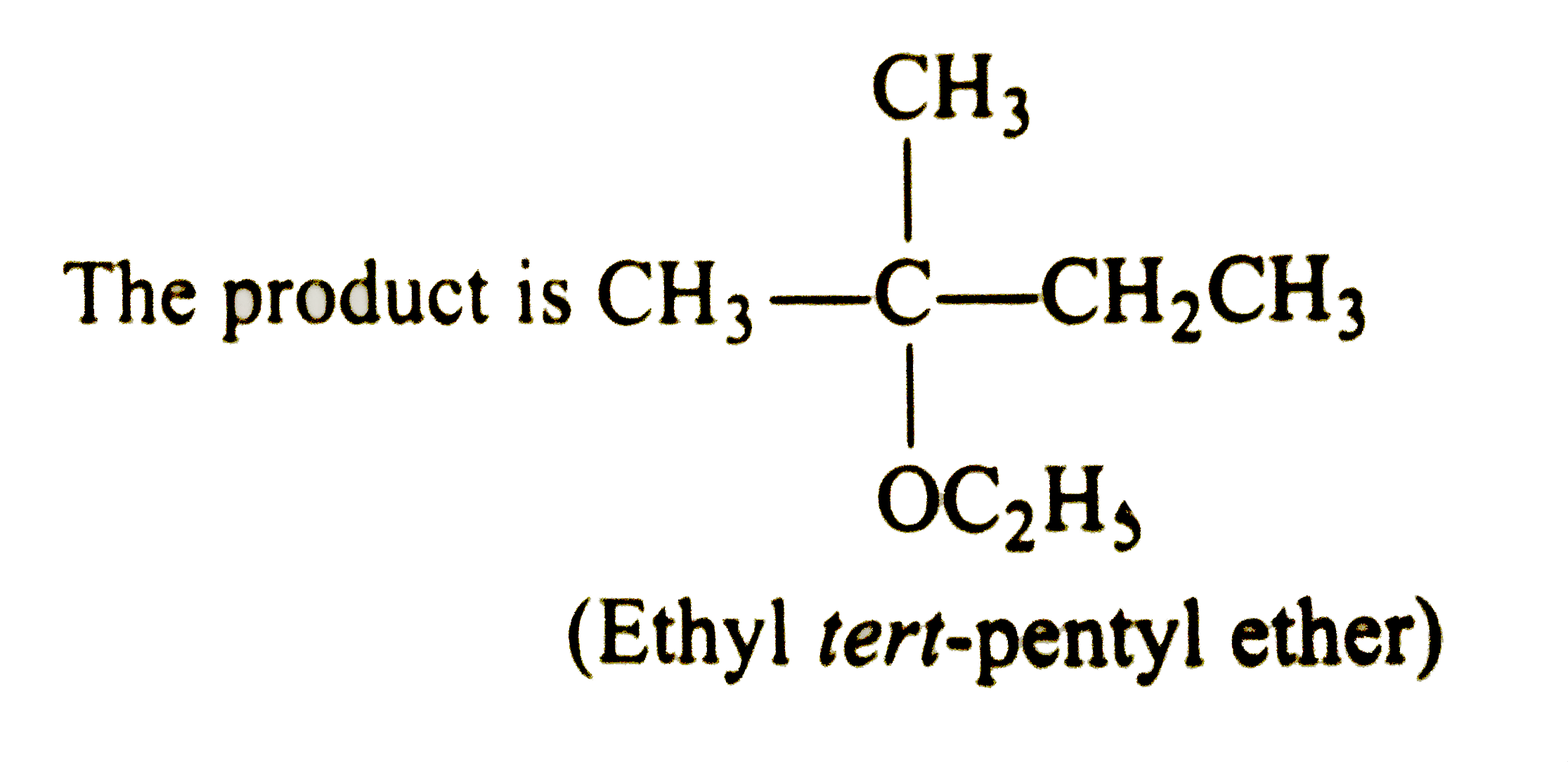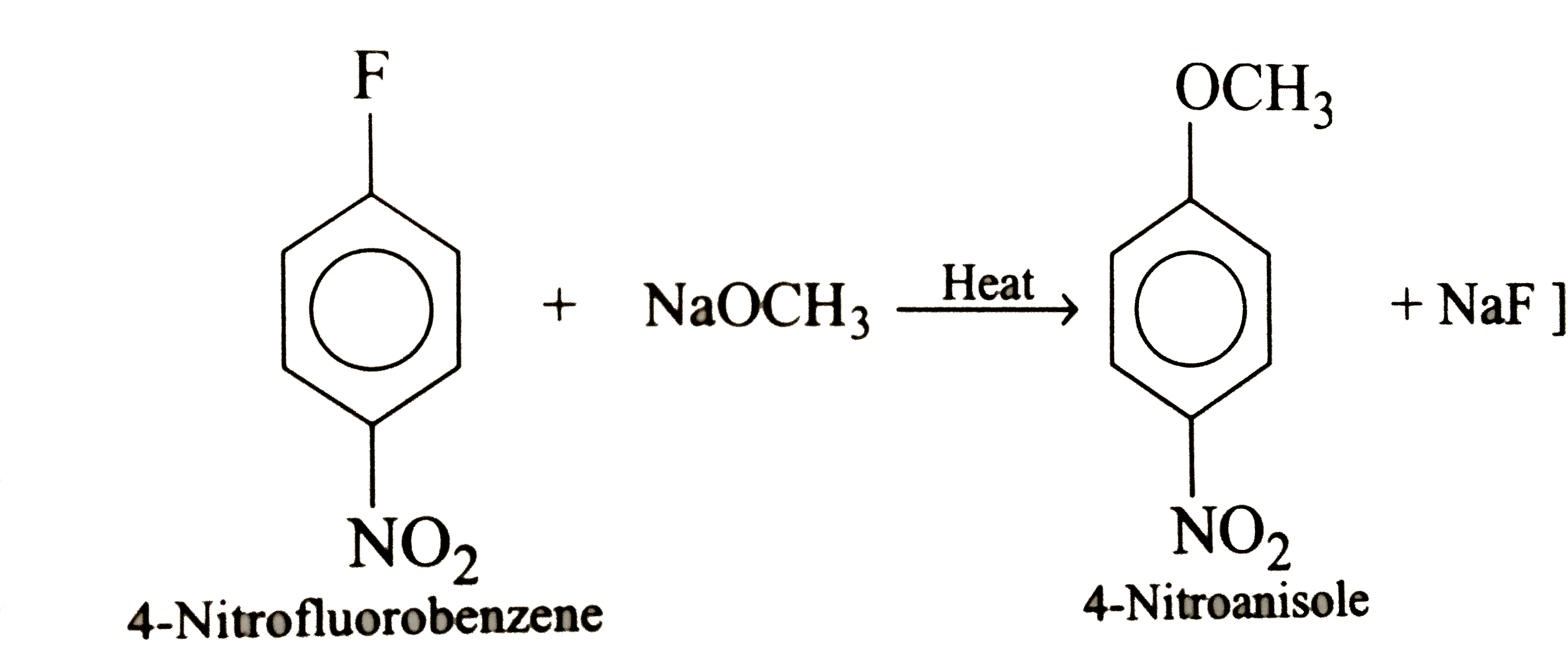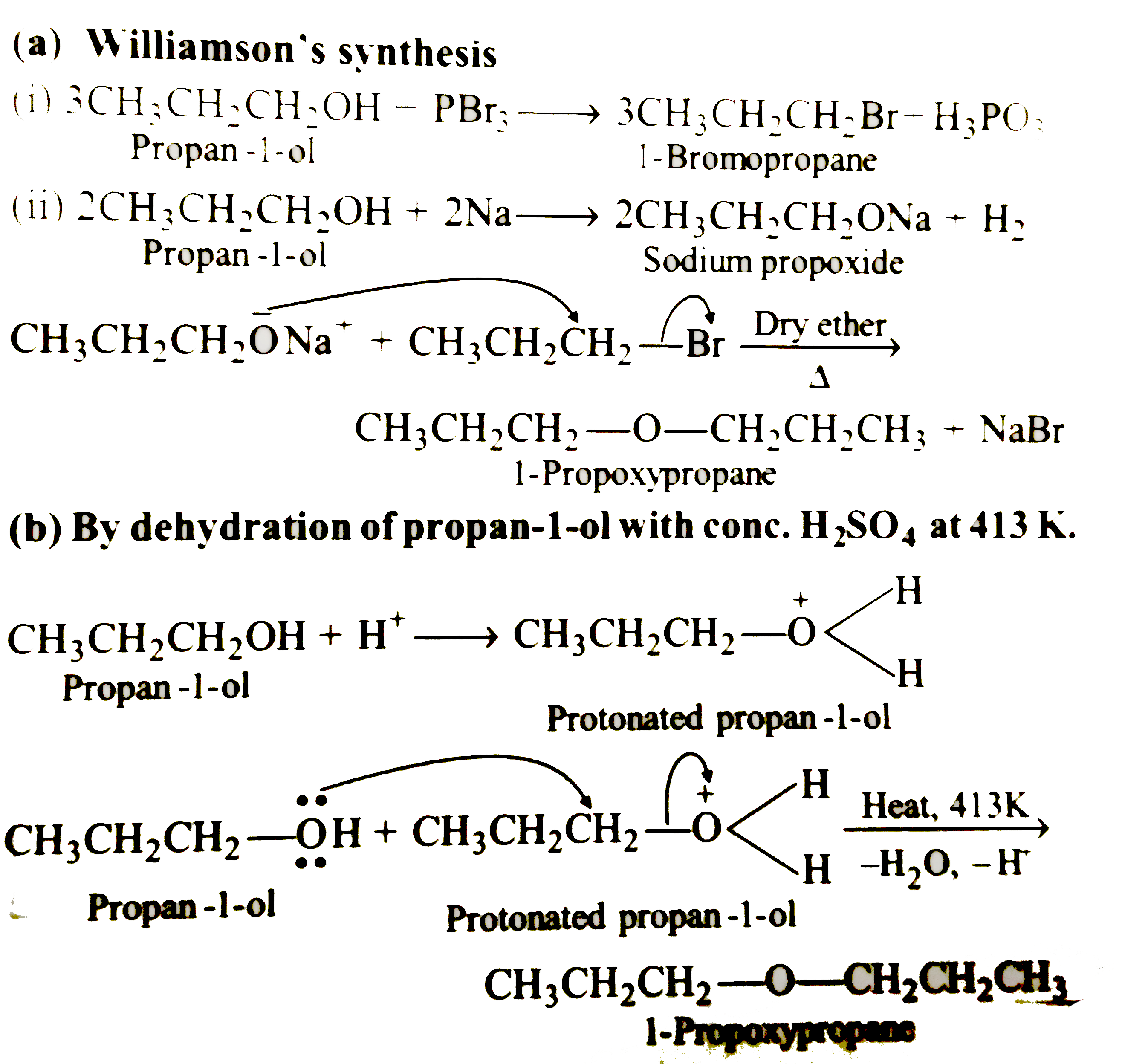Answer the following :
(i) What is the synthetic utility of the reaction RMgX or Rli with ethylene oxide ?
(ii) How is di-tert-butyl ether synethsised ?
(iii) What product is formed when, HOCH2CH2CH2OH is heated with conc. H2SO4 ?
(iv) The following reaction gives two product. Write the structures of the products .
(CH3)2CH−O−CH3HI(excess)−−−−−−−−→Δ
(v) What would be major product in the following reaction ?
CH3−CH3∣C∣CH3−CH2BrC2H5ONa/C2H5OH−−−−−−−−−−−−−−−→Δ
(vi) Sodium metal can be used for drying diethyl ether but not ethanol.
(vii) What products are obtained when :
(viii) Di tert-butyl ether cannot be obtained by Williamson's synthesis.
(ix) A mixture of ethyl alcohol and n-propyl alcohol on treatment with conc. H2SO4 gives a mixture of three ethers.
(x) Ethers can be cleaved only by acids and not by bases.
(xi) Predict the product of the follwowing reaction :

(xii) The following is not an appropriate reaction for the preparation of tert-butyl ethyl ether.
CH3−CH3∣C∣CH3−Cl+NaOC2H5→CH3−CH3∣C∣CH3−C2H5
(a) What would be the major product of this reaction ?
(b) Write a suitable reaction for the preparation of tert-butyl ethyl ether.
(xiii) How is 1-propoxypropane synthesized from propan-1-ol? Write mechanism of this reaction.
(i) It is a good method for extending R group of organometallic by −CH2CH2OH is one step.
(ii) 2Me3C−ClAg2CO3−−−−→Me3C−O−CMe3
(iii) Tetrahydrofuran is formed 
(iv) The two products obtained are (CH3)2CH−I and CH3I. In the presence of excess of HI, the initially formed alcohol is also converted to iodide.
(v) The product is 
as the reaction proceeds via SN1 mechanism with rearrangement of neopentyl carbocation to tert-pentyl carbocatin .
(vi) Sodium metal reacts with ethanol to form sodium ethoxide. On the contrary, ethers do not have replaceable hydrogen atom and therefore, do not react with sodium.

(viii) To prepare di-tert-butyl ether, the reagents to be used are tert-butyl bromide and sodium tert-butoxide. Since, the tertiary bromide (3∘) prefers to undergo elimination ( rather than substitution ) , therefore , the major product obtained is isobutylene and not di-tert-butyl ether.
CH3−CH3∣C∣CH3−Brtert-Butyl bromide(3∘)++Na−O−CH3∣C∣CH3−CH3Sodium tert-butoxide(−NaBr)−−−−−−→CH3−CH3∣C=CH2Isobutylene+CH3−CH3∣C∣CH3−OH
(ix) The 1∘ alcohols, i.e., ethyl alcohol and n-propyl alcohol (both ) yilds equally stable carbocation s and each one of which can be attacked either by ethyl or n-propyl alcohol to give a mixture of three ethers.
CH3CH2OHEthyl alcohol+CH3CH2CH2OHn-propyl alcoholH2SO4−−−−−−→(conc.)(CH3CH2)2ODiethyl ether+CH3CH2O−CH2CH2CH3Ethyl-n-propyl ether+(CH3CH2CH2)2ODi-n-propyl ether
(x) The C−..O..−C bond in ethers is very strong. The addition of acid forms protonated ether which is attacked by nucleophiles (Br− or I−) on the less hindered alkyl groups to bring the cleavage of ethers to form alkyl halide and an alcohol.
CH3CH2−..O..−CH3+H+→CH3CH2−+..O∣H−CH3Protonated etherBr−−−→CH3Br+CH3CH2OH
Ethers themselves are Lewis bases and are not attacked by strong bases.
(xi) As the nitro group is highly deactivating in nature , it will make the cleavage of C-F bond very easy, i.e., F− ions can be replaced by −−OCH3ion

(xii) (a) The major product of the given reaction is 2-methylprop-1-ene. It is because sodium ethoxide is a strong nucleophile as well as strong base. Thus, elimination predominates over substitution reaction.
(b) CH3−CH3∣C∣CH3−−ONa+Sod. tert-butoxide+ClCH2CH3Ethyl chloride→CH3−CH3∣C∣CH3−OCH2CH3tert-Butyl ethyl ether
(xiii) 
Topper's Solved these Questions
- ALCOHOLS, PHENOLS AND ETHERSBook:OP TANDONChapter:ALCOHOLS, PHENOLS AND ETHERSExercise:PROBLEMS BASED ON STRUCTURE AND PROPERTIES
Explore 7 Videos
- ALCOHOLS, PHENOLS AND ETHERSBook:OP TANDONChapter:ALCOHOLS, PHENOLS AND ETHERSExercise:BRAI STORMING PROBLEMS
Explore 32 Videos
- ALCOHOLS, PHENOLS AND ETHERSBook:OP TANDONChapter:ALCOHOLS, PHENOLS AND ETHERSExercise:PHENOLS
Explore 91 Videos
- ALDEHYDES AND KETONES Book:OP TANDONChapter:ALDEHYDES AND KETONES Exercise:SINGLE INTEGER ANSWER TYPE QUESTIONS
Explore 10 Videos
Similar Questions
The following is not an appropriate reaction for the preparation of t-butyl ethyl ethers.
C2H5ONa+CH3−CH3∣C∣CH3−Cl→CH3−CH3∣C∣CH3−OC2H5
(i) What would be the major product of this reaction ?
(ii) Write a suitable reaction for the preparation of tert-butylethyl ether.
View SolutionThe following is not an appropriate reaction for the preparation of t-butylethyl ethers.
C2H5ONa+CH3−CH3∣C∣CH3−Cl→CH3−CH3∣C∣CH3−OC2H5
(i) What would be the major product of this reaction ?
(ii) Write a suitable reaction for the preparation of tert-butylethyl ether.
View Solution
Knowledge Check
The major product formed in the reaction is:
CH_(3)-underset(H)underset(|)overset(CH_(3))overset(|)(C)-CH_(2)Brunderset(CH_(3)OH)overset(CH_(3)O^(Ө))toACH3−CH3∣C∣H−CH2OCH3BCH3−C∣OCH3H−CH2CH3CCH3−CH3∣C=CH2DCH3−CH3∣C∣OCH3−CH3
What would be the major products in the following reactions:
CH3−CH3∣C∣CH3−CH2BrC2H5OH−−−−→Δ
View SolutionWhat would be the major products in the following reactions:
CH3−CH3∣C∣CH3−CH2BrC2H5OH−−−−→Δ
View SolutionWhat would be the major products in the following reactions:
CH3−CH3∣C∣CH3−CH2BrC2H5OH−−−−→Δ
View SolutionThe following is not an appropriate reaction for the preparation of t-butyl ethyl ether.
C2H5ONa+CH3−CH3| C| CH3−Cl→CH3CH3| C| CH3−OC2H5
(i) What would be the major product of this reaction ?
(ii) Write a suitable reaction for the preparation of t-butylethyl ether.
View SolutionThe following is not an appropriate reaction for the preparation of t-butyl ethyl ether.
C2H5ONa+CH3−CH3| C| CH3−Cl→CH3CH3| C| CH3−OC2H5
(i) What would be the major product of this reaction ?
(ii) Write a suitable reaction for the preparation of t-butylethyl ether.
View SolutionThe following is not an appropriate reaction for the preparation of t- butylethyl ether :
C2H5ONa+CH3−CH3| C | CH3−Cl→CH3−CH3| C | CH3−OC2H5
(i) What would be the major product of the reaction ?
(ii) Write a suitable reaction for the preparationof ter-butyl ethyl ether.
View SolutionThe following is not an appropriate reaction for the the preparation of t-butyl ethyl ether
C2H5ONa+CH3−CH3∣C∣CH3−Cl→CH3−CH3∣C∣CH3−OC2H5
(i) What would be the major product of this reaction?
(ii) Write a suitable reaction for the preparation of t-butyl ethyl ether?
(b) give reason for the higher boiling point of ethanol in comparison to methoxymethane.
View Solution

